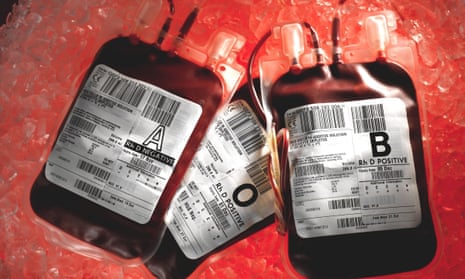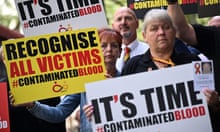Evidence of medical cover-ups in the NHS’s contaminated blood scandal must be investigated and those responsible encouraged to apologise, the infected blood inquiry has been told.
Q&AWhat is the NHS infected blood scandal?
Show
The infected blood inquiry will investigate how thousands of people with the blood-clotting disorder haemophilia were given blood products by the NHS which were contaminated with the HIV virus and hepatitis C.
At least 4,689 British haemophiliacs are thought to have been treated with infected blood in the 1970s and 80s. So far, half have died.
The inquiry will try to figure out the exact number of people who have been infected, examine the impact the infection had on people’s lives, investigate whether there was any attempts to conceal details of what happened, and identify any individual responsibilities as well as systemic failures.
On its second day, Aidan O’Neill QC, representing nearly 250 victims and relatives, told the inquiry that the medical treatment records of many patients had either disappeared or, in some cases, had “false information” added.
Patients have been left with their faith in the NHS shattered, he said. “What they have been faced with is stonewalling, secrecy and evasion – a lack of candour. People have been left fearful, their lives dogged by depression.”
Many victims believed their experiences amounted to evidence of a cover-up, O’Neill said. “A number of people who have spoken to me independently have come with such similar strands of medical records disappeared, of medical records filleted so that record of treatment is gone.
“It’s happened in so many cases and we want to know why. How has this happened?” In some cases, he said, “false information had been added”, for example, suggesting that they had other conditions such as alcoholism which had caused liver damage.
“The risks were known about the possibility of blood-borne infection well before the experience and knowledge of HIV … We have heard from so many that people were not advised about the risks of the blood products. Their consent was not even sought.
“Many were not told they had become infected even when the transmission pathways were already known … Why did doctors know so little when it was common knowledge among transfusion [staff]?”
The attitude of some doctors had been defensive and insensitive, O’Neill said. Some medical staff viewed those complaining about treatment as motivated only by obtaining money through compensation claims.
In one case, a doctor referred to twins as “young pups”. The boys thought that meant the doctor liked them, O’Neill explained. “They didn’t know it was an acronym for Previously Uninfected Patients.” Two police investigations have been launched in Scotland into blood transfusion cases, O’Neill said, but few details have emerged about their inquiries.
Sam Stein QC, who represents four core participants in the inquest, said anyone who knowingly passed on infected blood committed the criminal offence of inflicting seriously bodily harm. If the victim died, he added, it would have been murder. Those who were involved in the supply chain would be guilty of conspiracy to murder.
“It’s clear,” Stein told the inquiry, “that those who were responsible for the criminal infection of people should be prosecuted.”
Stein said that in the UK, 4,500 haemophilia sufferers were given HIV and hepatitis C and half of those people have since died.
The evidence discovered suggests that several state bodies, including the NHS, actively pursued observation and testing although patients were not told, Stein alleged. “We say there was a systematic attempt to destroy documents. Documents that should have been passed to the National Archives disappeared … We say that there was a systematic attempt to destroy evidence, avoid the truth and thereby abdicate responsibility for the actions of the state and its representatives.”
He added: “The least any patient should expect before undergoing any treatment, let alone experimental treatment, is to feel safe in the knowledge that they have been allowed to make an informed decision to undergo that treatment with the full knowledge of the potential risks and consequences of that treatment.
“The last thing any human being should become is an unwitting guinea pig or lab rat, but that is precisely what happened to haemophiliacs.”
Theresa May announced in July last year that an inquiry would be held into events in the 1970s and 80s, when thousands of people with haemophilia and other patients were given infected blood products.
David Lock QC, who represents around 240 victims and their relatives, said patients had not only been infected with HIV and hepatitis C but a wide range of other pathogens, potentially including new variant Creutzfeldt-Jakob disease.
He said few people in the general population sustained brain damage from that disease after the scandal over contaminated beef, but “the real risk of developing NV CJD is something which my clients have to live through every day”.
He added that key “incriminating” documents in the Department of Health may have been destroyed by civil servants in order to draw a line under the scandal. “We understand that that these may have included the private papers of [the former health secretary] David Owen.”
If copies of those documents existed in other government files, they should be found, he said. “Whatever the financial cost, the time for secrecy is over.”
There has been an assumption that the infected blood came from abroad. “It will be for this inquiry to determine whether this was a correct picture or a convenient myth.”
There is no agreed figure about about how many victims there have been. One core participant, Paul Desmond, told the inquiry on Tuesday that infection rates may have been far higher than generally accepted, possibly resulting in up to 300,000 patients being infected with HIV, Hepatitis and other pathogens by 1990. That figure is not supported by other campaigners.








